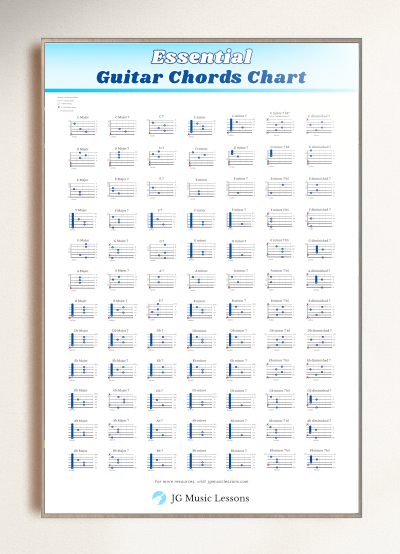The blues is one of the music styles that many guitarists love because it’s a simple yet fun chord progression that allows for improvisation and an exchange of musical ideas amongst musicians.
A standard blues is also commonly referred to as a 12 bar blues, meaning it has 12 measures to make up the entire form. In its most basic form, the blues is made up of 3 chords: the 1, 4, and 5 chord in relation to the key of the song.
In today’s lesson, we are covering 3 levels of harmony (chords) you can use to play a blues form on the guitar using:
- Power chords
- 7th chords
- Jazz chords (extended harmony)
Before explaining what chords you can use in a blues, let’s first go over some basic harmony included in 12 bar blues form. Feel free to skip this section if you’re already familiar with this.
Understanding the number system
To follow chord changes in a form, you should be familiar with the number system to know what the related chords are used in any given key.
For example, here are the chord qualities that start on each degree of a Major scale:
- Degrees 1, 4 and 5 are Major chords.
- Degrees 2, 3, and 6 are minor chords.
- 7th degree is a diminished chord.
In the key of C Major these are your diatonic chords (meaning the related chords to the key):
- 1 is C Major
- 2 is D minor
- 3 is E minor
- 4 is F Major
- 5 is G Major
- 6 is A minor
- 7 is B diminished
Using this number system will help find all the related chords to any key.
Basic 12 bar blues form
Regardless of what key you want to play in, here are the following chords in a blues progression. I’ll choose the key of A for this example.

Although you can play this with open chords, there are much better ways to get a more authentic blues sound. For example, all these chords can be changed into 7th chords and we can also change the rhythm which will be explained in more detail later on in this lesson.
Now that we have an understanding of the chord progression in it’s basic form, let’s go through the different ways we can play this, starting from the simplest to more advanced harmony.
Level 1: Blues with power chords
In this first level, we’ll use power chords to play the blues form. These power chords are simple chord structures that don’t include the 3rds of a chord, which indicate whether a chord has a Major or minor quality. You can check this link to learn more about triads if you want to understand this in more detail.
These power chords are movable shapes, which make it a very simple and straightforward approach that sound more like rock.
Power chords are notated by a number 5 next to the root note because you only play the root and interval of a 5th.
Power chord charts
Here is what the 3 chords look in power chord form:

Blues with power chords – rhythm example
Here is a blues progression using power chords only. The rhythm is kept pretty simple to reflect the style of chords we’re using here.

Level 2: Blues with 7th chords
To take things to the next level, we start to use 7th chords which are a characteristic sound that makes the blues unique. 7th chords contain another note above a triad and are made up of the chord tones 1, 3, 5, and 7. Depending on the 3rd and 7th degree, you can form different 7th chords such as Major 7, dominant 7th, minor 7 or half diminished (minor 7 b5).
If we use the diatonic chords, we would usually use Major 7 chords on the 1 and 4 chord. However, when playing blues, you would use Dominant 7 chords on the 1 and 4 chord. Even though some notes don’t technically ‘fit the key’, these chords sound good when played in a sequence.
You can compare the difference between Major 7 and Dominant 7 chords with this chart below:

When playing 7th chords, you only need to play certain notes to highlight the chord quality. For example, even if you only play the 3rd and 7th of a chord, you get the important notes that make up a chord’s structure and sound. You can also add root notes to give more emphasis on a particular chord. By playing the root, 3rd, and 7th of a chord, you get what are called shell chords.
7th chord charts
Take a look at what these 7th chords using shell chord shapes would look like in a blues in A. The 3 chords are A 7, D 7 and E 7.


Blues with 7th chords – rhythm example
For the rhythm in level 2, we can play the form in swing feel which you also hear in jazz. Instead of playing straight 8th notes which are equally divided in time, swing feel lengthens the notes of certain 8th notes. You could think of the ‘and’ of each beat as the third beat of a triplet. Check out the image below to show you what I mean.

Here is the blues form now using all 7th chords:

Level 3: Blues with jazz chords
In level 3, we start using more advanced harmony which uses chord extensions past the 1, 3, 5, and 7 chord tones. These can be referred to as jazz chords which you also hear in blues and use chord extensions like the 9th, 11th, and 13th which can sound fuller and richer.
Building upon the previous shell chords, we’ll add these extensions to the shapes covered in level 2.
Jazz chord charts
Here are the chord shapes we will be using for the example ahead. As you can see, we are adding one more chord that acts as a passing chord between the E7(9) and D7(9) in measure 9.

Blues with power chords – rhythm example
For the rhythm, we are keeping the swing feel and also adding more accents throughout the form. You will see that some chords are anticipated by playing on the ‘and’ of beat 4 on the previous measure.

12 bar blues chords chart
The following chart will show you the 3 basic chords in a 12 bar blues: the 1, 4, and 5 chord in every key.
| Key center (1 chord) | 4 chord | 5 chord |
|---|---|---|
| C | F | G |
| Db | Gb | Ab |
| D | G | A |
| Eb | Ab | Bb |
| F | Bb | C |
| Gb | B | Db |
| G | C | D |
| Ab | Db | Eb |
| A | D | E |
| Bb | Eb | F |
| B | E | F# |
Once you know the root note for every chord in a 12 bar blues, you can experiment with the chords we covered in this lesson from easy to more advanced variations.
Wrapping up
Learning to play the blues is a fun way to build your guitar skills, allowing you to share musical ideas with other musicians as well as solo-style playing. Although a standard blues is made up of a simple 12 measure progression, there are many different ways to express this style of music, depending on the chords and rhythm that you use.
In this lesson, we covered 3 different levels of playing the blues from easiest to more difficult. We also reviewed the number system and how the blues slightly bends the traditional rules of harmony to give this genre its unique sound.
I hope this information gave you a better understanding of the blues and the different ways you can approach it by using simple triads to jazz chords. You can check out how to build extended chords on guitar for further learning.
I would recommend you trying these chords in different keys and also explore different rhythms to play the blues.
After learning this standard 12 bar blues, also check out how to play a minor blues progression.
For improvisation ideas to play over the blues, learn the pentatonic scale and blues scale or learn these 7 jazz and blues licks over a dominant 7 chord.
📘 Get the free guitar practice guide here!
All the best,
JG Music Lessons
Start Playing Better, Faster
with Pro Membership! ✨
Get the guidance, tools, and support that keep your progress on track:
🏁 Always know what to practice next. Access the full Guitar Learning Roadmap with lessons in sequence.
🎼 Play songs with confidence. Step-by-step lessons of popular, classical pieces and other styles.
📙 Save time and frustration. Clear PDFs and ebooks that save time so you can focus on playing.
🎟️ Get rewarded for consistency. 2 free downloads every month (a $240+ yearly value).
🎁 Keep costs low while you grow. 50% off all charts, tracks, and posters — up to 75% off bundles.
🚫 Stay focused. Ad-free environment keeps you in the zone.
💬 Get help when you need it. Direct member support to keep you on track.

